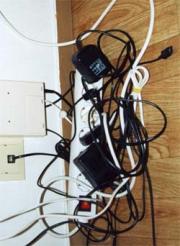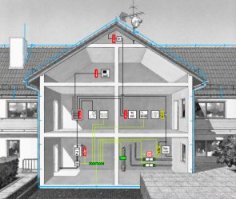Categories: Sharing experience, Novice electricians, Electrician Secrets
Number of views: 666,687
Comments on the article: 29
About grounding and grounding for "dummies"
 My bitter experience as an electrician allows me to say: If you have the "grounding" done as it should - that is, the shield has a connection point for the "grounding" conductors, and all the plugs and sockets have "grounding" contacts - I envy you, and there’s nothing for you worry.
My bitter experience as an electrician allows me to say: If you have the "grounding" done as it should - that is, the shield has a connection point for the "grounding" conductors, and all the plugs and sockets have "grounding" contacts - I envy you, and there’s nothing for you worry.
Grounding Rules
What is the problem, why can not you connect the ground wire to the heating or water pipes?
Actually, in urban conditions, stray currents and other interfering factors are so great that anything can appear on the heating battery. However, the main problem is that the trip current of the circuit breakers is quite large. Accordingly, one of the options for a possible accident is a breakdown of a phase to a case with a leakage current just somewhere on the boundary of the operation of the machine, that is, in the best case, 16 amperes. Total, we divide 220v by 16A - we get 15 ohms. Just some thirty meters of pipes, and get 15 ohms. And the current flowed somewhere, in the direction of not sawn wood. But that is no longer important. The important thing is that in the neighboring apartment (up to which 3 meters, and not 30, the voltage on the tap is almost the same 220.), but on, say, the sewer pipe - a real zero, or so.
And now the question is - what will happen to the neighbor if he, sitting in the bathroom (connected to the sewer by opening the cork), touches the tap? Guessed?
The prize is prison. According to the article on violation of electrical safety rules that caused the victim.
Do not forget that you can not do an imitation of the "grounding" circuit, connecting the "zero working" and "zero protective" conductors in the Euro socket, as some "craftsmen" sometimes practice. Such a replacement is extremely dangerous. Cases of burning off the “working zero” in the shield are not rare. After that, on the case of your refrigerator, computer, etc. Very firmly placed 220V.
The consequences will be about the same as with the neighbor, with the difference that no one will be responsible for this, except for the one who made such a connection. And as practice shows, the owners themselves do it, because They consider themselves specialists enough not to call electricians.
Grounding and Grounding
 One of the options for grounding is grounding. But not as in the case described above. The fact is that on the switchboard housing, on your floor there is zero potential, or more precisely, the zero wire passing through this same shield simply has contact with the switchboard housing through bolted connections. Zero conductors from the apartments located on this floor also join the shield body. Let's look at this moment in more detail. What we see, each of these ends is wound under its own bolt (in practice, the truth is often found in pairs by connecting these ends). This is where our newly-made conductor, which will later be called "ground", must be connected.
One of the options for grounding is grounding. But not as in the case described above. The fact is that on the switchboard housing, on your floor there is zero potential, or more precisely, the zero wire passing through this same shield simply has contact with the switchboard housing through bolted connections. Zero conductors from the apartments located on this floor also join the shield body. Let's look at this moment in more detail. What we see, each of these ends is wound under its own bolt (in practice, the truth is often found in pairs by connecting these ends). This is where our newly-made conductor, which will later be called "ground", must be connected.
This situation also has its own nuances. What prevents the "zero" burn at the entrance to the house. Actually, nothing. One can only hope that there are fewer houses in the city than apartments, which means that the percentage of occurrence of such a problem is much less. But this is again the Russian "maybe", which does not solve the problem.
Ground loop
 The only right decision in this situation. Take a metal corner 40x40 or 50x50, length 3 meters, drive it into the ground so that it does not stumble, namely, we dig a hole two shovels in the depths and drive our corner there as far as possible, and wire PV-3 from it (flexible stranded), with a cross section of at least 6 mm. sq. up to your switchboard.
The only right decision in this situation. Take a metal corner 40x40 or 50x50, length 3 meters, drive it into the ground so that it does not stumble, namely, we dig a hole two shovels in the depths and drive our corner there as far as possible, and wire PV-3 from it (flexible stranded), with a cross section of at least 6 mm. sq. up to your switchboard.
Perfectly ground loop It should consist of 3-4 corners, which are welded with a metal strip of the same width. The distance between the corners should be 2 m.
Just do not drill a hole in the ground meter drill and lower the pin there. It is not right. And the efficiency of such grounding is close to zero.
But, as in any method, there are drawbacks. Of course, you are lucky if you live in a private house, or at least on the ground floor. But what about those who live the floor at 7-8? Stock up on a 30-meter wire?
So how do you find a way out of this situation? I'm afraid that even the most experienced electricians will not give you the answer to this question.
What is required for house wiring
For wiring around the house you will need a copper ground wire of the appropriate length and a cross section of at least 1.5 mm. sq. and, of course, a socket with a grounding contact. A box, a plinth, a bracket are a matter of aesthetics. The ideal option is when you make repairs. In this case, I recommend choosing a cable with three cores in double insulation, preferably VVG. One end of the wire is led under the free bolt of the switchboard busbar connected to the switchboard housing, and the other end is connected to the "ground" pin of the outlet. If there is an RCD in the shield, the grounding conductor should not have any contact with the N conductor anywhere on the line (otherwise the RCD will trip).
Do not forget that the "earth" does not have the right to be torn, through any switches.
Read also on this topic:Grounding and grounding - what is the difference?
See also at e.imadeself.com
:
